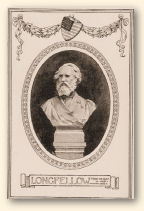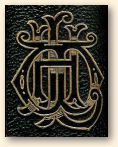Gedenkjaar
Nu de Amerikaanse dichter Henry Wadsworth Longfellow (1807-1882) één en een kwart eeuw na zijn overlijden, deze maand wordt herdacht met een speciale postzegel, uitgegeven door de US Postal Services, is het wellicht ook aardig om hem op deze plaats, waar wij nog niet zo heel lang geleden — om precies te zijn was dat op zondag 11 maart, naar aanleiding van een BBC-radioprogramma — al een gedicht van hem hebben opgenomen, deze poëet eveneens te herdenken, als tegenwicht tegen die formalistische Yanks. Daarvoor hebben we twee van zijn talrijke gedichten uitgekozen.
THE POET AND HIS SONGS
As the birds come in the spring,
We know not from where;
As the stars come at evening
From the depths of the air;
As the rain comes from the cloud,
And the brook from the ground;
As suddenly, low or loud,
Out of silence a sound;
As the grape comes to the vine,
The fruit to the tree;
As the wind comes to the pine,
And the tide to the sea;
As come the white sails of ships
O’er the ocean’s verge;
As comes the smile to the lips;
The foam to the surge;
So come to the Poet his songs,
All hitherward blown
From the misty land, that belongs (*)
To the vast Unknow.
His, and not his, are the lays
He sings; —and their fame
Is his, and not his; —and the praise
And the pride of a name.
For voices pursue him by day,
And haunt him by night,
And he listens, and needs must obey,
When the Angel says: “Write!”
*****
(*) In de Oxford-editie (1910) van Longfellows
Poetical Works luidt deze regel:
From the misty realm, that belongs
*****
Het tweede is een poëtische dankbetuiging aan de kinderen van Cambridge, Massachussetts, die hem ter gelegenheid van zijn tweeënzeventigste verjaardag, op 28 februari 1879, een leunstoel hebben aangeboden, die was vervaardigd uit het hout van een kastanjeboom, die toebehoorde aan de dorpssmid.
FROM MY ARM-CHAIR
AM I a king, that I should call my own
This splendid ebon throne?
Or by what reason, or what right divine,
Can I proclaim it mine?
Only, perhaps, by right divine or song
It may to me belong;
Only because the spreading chestnut tree
Of old was sung by me.
Well I remember it in all its prime,
When in the summertime
The affluent foliage of its branches made
A cavern of cool shade.
There, by the blacksmith’s forge beside the street
Its blossom white and sweet
Enticed the bees, until it seemde alive,
And murmured ike a hive.
And when the winds of autumn, with a shout,
Tossed its great arms about,
The shining chestnuts, bursting from the sheath
Dropped to the ground beneath.
And now some fragments of its branches bare,
Shaped as a stately chair,
Have by my hearth-stone found a home at last,
And whisper of the Past.
The Danish king could not in all his pride
Repel the ocean tide,
But seated in this chair, I can in rhyme
Roll back the tide of Time.
I see again as one in vision sees,
The blossoms and the bees,
And hear the children shout and call,
And the brown chestnuts fall.
I see the smithy with its fires aglow,
I hear the bellows blow,
And the shrill hammers on the anvil beat
The iron white with heat!
And thus, dear children, have ye made for me
This day a jubilee
And to my more than threescore years and ten (**)
Brought back my youth again.
The heart hath its own memory, like the mind
And in it are enshrined
The precious keepsakes, into which are wrought
The giver’s loving thought.
Only your love and your remembrance could
Give life to this dead wood,
And make these branches, leafless now so long,
Blossom again in song.
[Beide gedichten uit Later Poems, ca. 1880]
*****
(**) Threescore staat gelijk aan zestig;
threescore and ten is derhalve zeventig.
*****
Afbeeldingen
1. Henry Wadsworth Longfellow, borstbeeld in Westminster Abbey. Overgenomen uit: Henry W. Longfellow: The Seaside and the Fireside, uitgegeven door Ernest Nister, London — in samenwerking met E.P. Dutton & Co., New York (zonder jaartal).
2. Siernaam op het voorplat van de band met The Poetical Works of Henry W. Longfellow, uitgegeven te Londen, door John Walker & Company, Farringdon House, Warwick Lane, E.C. (zonder jaartal).
3. HWL-siermonogram op de rug van diezelfde band.
